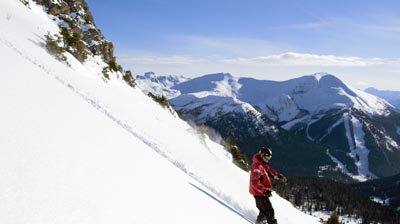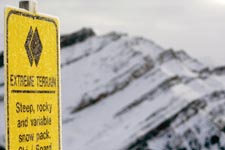 |
|
Snowboard instructor, Jack Kuntze rips down a face that is part of Alberta's Lake Louise Ski Resort's 11 square miles of inbounds and avalanche controlled terrain that few people make the effort to get to. |
WILL COLFORD
LAKE LOUISE, AB — “If you can see it, you can ski it,” said public relations director, Sandy Best. As an Albertan, I know Lake Louise like an old ski coat, or so I thought. However, Best and a three-year ski school vet, Jack Kuntze (JK), showed me the real Lake Louise, and it’s unbelievable.
Before delving into what I didn’t know, I’ll start with what I did. Lake Louise is a name that carries international weight. There’s a green run from every chair lift, so families can ride together all day long, from anywhere on the hill. However, Lake Louise also has a large amount of advanced terrain accessible by lift, located on the backside of the mountain: Whitehorn, Brown Shirt, Gullies A through H, and the Diamond Mines (which won't be found on any trail map today).
Right there for the taking
This particular terrain, then, constitutes a good chunk of Lake Louise’s 4,011 acres of named lift accessible runs. This is the Lake Louise I know. The 11 square mile land lease, however includes inbound backcountry-style terrain (a portion of which is not avalanche controlled) is the Louise I never knew existed, even though its in plain sight and reserved for anyone eager and motivated.
The terrain, according to Best, is the real reason, “Lake Louise has such an international reputation.” After seeing it, then skiing it first hand, I am inclined to agree. Elevator Shaft, Wolverine Ridge, Purple Bowl and Richardson’s Ridge are some of the places where the motivated can get fresh tracks and challenging turns all day long.
“Just because most of these places are controlled," warns JK, “doesn’t mean you should just head back without any knowledge or preparation.” After all, avalanches have even occurred in bounds on some resorts within recent years, let alone the inbounds backcountry, slack country, and side country that has become increasingly popular and increasingly dangerous for the uneducated, unprepared, and disrespectful to the forces of nature.
Stick to the rules

Regardless of which resort you are at, obeying the posted signage – especially in advanced terrain, is the best way to stay safe and aware of your surroundings. |
Best, however, knows, "people are going to go into the backcountry, which is why Lake Louise has set up programs to educate people on proper backcountry techniques, transceiver usage, and simple avalanche detection methods.”
Again, even the most knowledgeable and experienced backcountry guides, and ski patrol can never fully predict an avalanche, Lake Louise just wants its clients to be as safe as possible. As such, in addition to the programs, there are two excellent ways to stay safe when heading to all the amazing places the Lake has to offer:
1) Never cross a rope that’s closed. If ski patrol has deemed it unsafe, then it’s unsafe. If you only follow one rule, let it be this one.
2) Ask where’s good. Again, Best wants people to experience the real Lake Louise, so going to ask ski patrol, or a knowledgeable vet like JK which hikes are safe, and which areas are good is a perfectly viable start. It’s inbounds so there’s no fear of trespassing. Asking the right person will net the best answers.